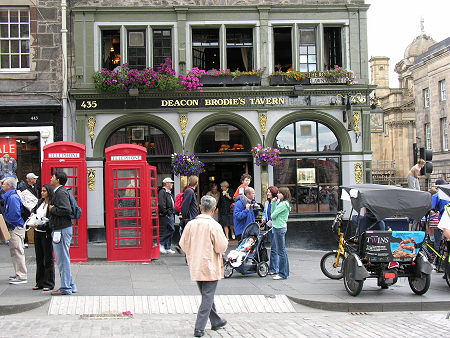| This Week’s Topic… | ||

Best viewed in
|
The Real Jekyll and Hyde Deacon William Brodie lived from 1741 to 1 October 1788. He was a pillar of Edinburgh society: a successful cabinet maker; Deacon of the Guild of Wrights and Masons; and an Edinburgh City Councilor. But he was also a man with a serious gambling habit who needed to maintain not just the family everyone knew about, but also two mistresses and five illegitimate children. William Brodie's father had been a cabinet maker before him, and William served an apprenticeship that led to his work being regarded as some of the best in Edinburgh. He grew to become a supplier of furniture to the rich and famous. Part of the work had to be undertaken in customers' homes and business premises, installing furniture or fitting locks. But Edinburgh had a dark side, an underworld of vice and crime, and Deacon Brodie came to know it well. He would frequent drinking and gambling dens, and by 1768 had run up serious debts to the sort of people you really wouldn't want to owe money to. His lifestyle was becoming increasingly expensive in other ways, too. By day he was a respectable family man: by night he maintained two mistresses (neither of whom knew of the other's existence) who between them had borne him five illegitimate children. Deacon Brodie first turned to crime as a means of resolving his problems in 1768, when he was able to take impressions of the keys to a bank in the city. His subsequent night-time robbery of the bank netted him £800, a large amount at the time. To further his criminal activities, Deacon Brodie recruited an English locksmith, George Smith, and between them they launched a highly successful crime wave across the city, even stealing Edinburgh University's silver mace. By 1786 Brodie's gang had grown to four, after he recruited two more members, Ainslie and Brown. Brodie was becoming more ambitious in his criminal activities, and later in 1786 planned an audacious raid on His Majesty's Excise Office in Chessel's Court, off Canongate. Brodie's role was to act as lookout, but he fell asleep. As a result the authorities, alerted to the robbery in progress, came very close to capturing the whole gang red-handed. In the event, Brodie and two others narrowly escaped, but Ainsley was captured. Ainsley quickly turned King's Evidence to avoid the gallows, and Smith and Brown were also arrested. Deacon Brodie fled to Amsterdam, where he lay low for a while, before being arrested on the point of boarding a ship bound for North America and returned to Edinburgh in chains. Brodie's trial began on 27 August 1788. He was convicted on the basis of the word of other members of the gang, and incriminating items found at his home, including a stock of duplicate keys, a disguise, and pistols. Brodie was hanged on 1 October 1788, at Edinburgh's Tolbooth, a grim building that stood in the middle of the High Street near St Giles' Cathedral. Ironically the gallows used was one for which Brodie, as a City Councilor, had himself helped authorize the funds. At least, he was probably hanged that day. Stories rapidly began to circulate that in an effort to cheat the noose, Brodie had worn a steel collar to the scaffold which, with instructions that he should be cut down quickly, had allowed him to survive the experience. Then someone reported having seen him in Paris. The truth - probably - was that he did indeed die on the gallows, and was then buried in a unmarked grave in the Borders. Though in some ways Deacon Brodie does still live on. His story is remembered in the naming of Deacon Brodie's Tavern on Edinburgh's Royal Mile; and a New York bar is also named after him. And Robert Louis Stevenson's fascination with the story of Deacon Brodie (who had supplied Stevenson's father with furniture) inspired him to write his classic novel: The Strange Case of Dr Jekyll and Mr Hyde.
|
|
